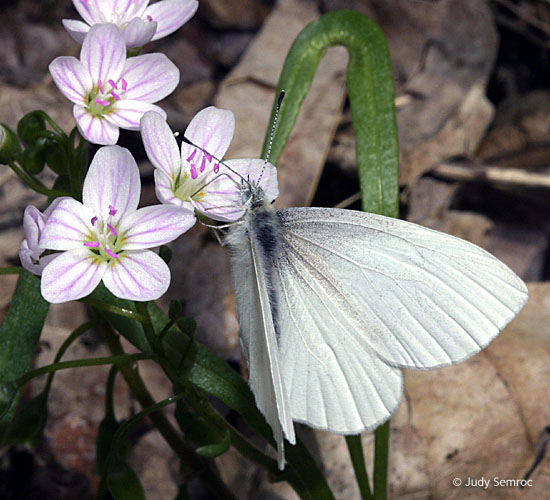West Virginia White Butterfly
The West Virginia White butterfly (Pieris virginiensis) is a small, white butterfly found in wooded habitats of the northeastern United States. The adult butterfly, which flies only in April and May, relies on spring wildflowers, such as toothwort, trillium, and violets, for its survival. Currently there are many threats to the natural areas where the butterfly and these wildflowers are found. These threats include forest fragmentation, deer overpopulation, and the spread of invasive species, such as garlic mustard. The butterfly is just one of the native residents of the forest that will be affected if we lose our natural areas and these spring wildflowers.

Members of the Lake Erie Allegheny Partnership for Biodiversity are dedicated to the identification, protection and restoration of biological diversity in our region. LEAP members have identified the West Virginia white butterfly as a “species of concern” in our region and have formed the West Virginia White Committee. The goals of this committee are to:
- maintain viable populations of the West Virginia white butterfly
- preserve and restore its habitat
- educate the public
Each April, members of LEAP begin monitoring suitable habitats for the presence of the butterfly. By learning more about this butterfly, we hope to gain an understanding of the threats against it and the native wildflowers it depends on for survival.
We are also asking for your help in finding the butterfly! During the months of April and May, as you are hiking through your favorite wooded areas please let us know if you see this small, white butterfly or its host plant, toothwort.
More information about the West Virginia White Butterfly can be found in this Conservation Plan and Bibliography.
Learn more about West Virginia Whites and Butterfly Monitoring
- Details on West Virginia White butterflies
- The Ohio Lepidopterists
- Status in New York Natural Heritage Program
- Mass Audubon Butterfly Atlas
Learn more about Garlic Mustard and other Invasive Plants
- How does Garlic Mustard affect West Virginia White?
- Ohio Invasive Plant Council Garlic Mustard Fact Sheet
- Details on Garlic Mustard from The Nature Conservancy
- US Forest Service Weed of the Week: Garlic Mustard
- Invasive Plants of Wisconsin
- New York Invasive Species Information
- Ohio Biennial Weed Guide
- Global Invasive Species Database
- Biological Control of Garlic Mustard in the Eastern United States (PDF)
Learn more about native Toothwort and Cress
Smooth Rock Cress
- Boechera laevigata - (Illinois Wildflowers)
- Boechera laevigata - (Eloise Butler Wildflower Garden)
- Boechera laevigata - (US Forest Service)
Cut-leaved Toothwort
- Cardamine concatenata - (Connecticut Botanical Society)
- Cardamine concatenata - (Missouri Botanical)
Two-leaved Toothwort
- Cardamine diphylla - (Eloise Butler Wildflower Garden)
- Cardamine diphylla - (Connecticut Botanical Society)